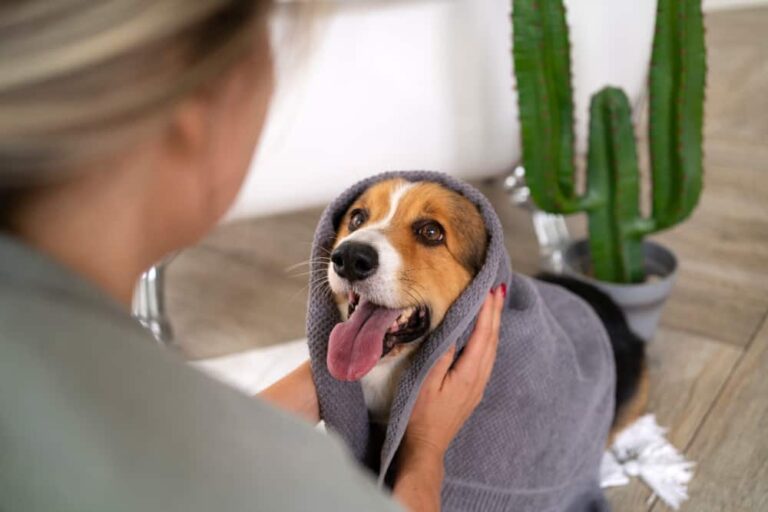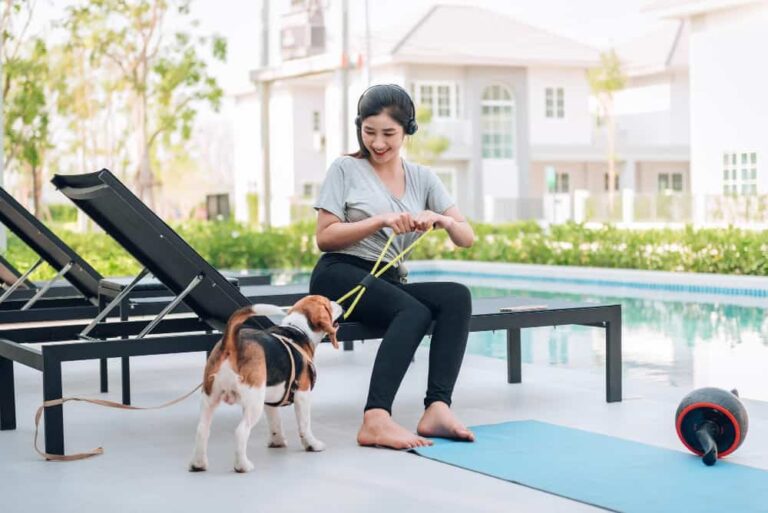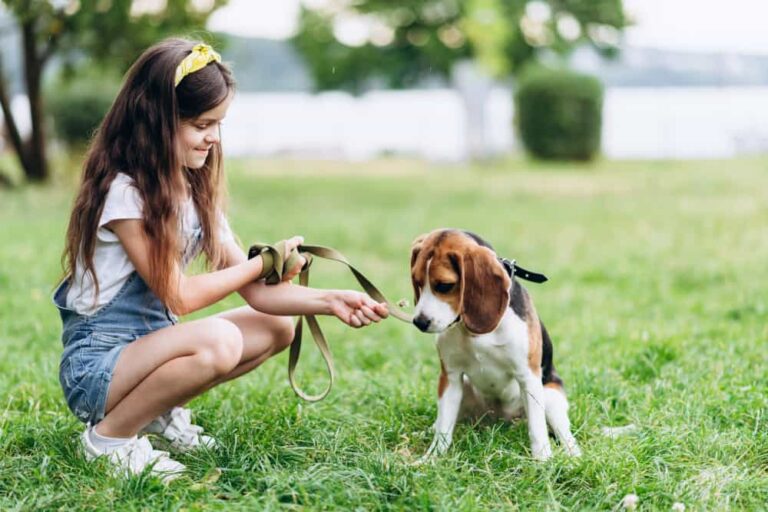Effective Tips How to Train Peeing in the House

Are you tired of constantly cleaning up after your dog’s indoor accidents? If you’re looking for effective strategies to train your dog to pee outside, you’ve come to the right place.
In this article, we’ll provide you with practical tips how to train dog not to pee inside. By observing your dog’s behavior, using positive reinforcement, and keeping them close to you, you can prevent accidents and encourage successful toilet training.
We’ll also discuss the importance of confining your dog when you’re not around and address specific approaches for puppies and older dogs. Additionally, we’ll touch on anxiety issues, the benefits of spaying or neutering, and ruling out any medical conditions that could contribute to accidents.
Whether you have a new puppy or a senior dog, create a clean and accident-free environment for you and your beloved companion.
Contents
- 10 Tips How to Train Dog Not to Pee Inside
- Re-train your dog to pee in the house.
- Rule out health problems.
- Create a routine
- Use positive reinforcement
- Limit access
- Never Punish
- Spay or Neuter Your Dog
- Identify and Eliminate Anxiety Triggers
- Get Professional Help
- Increase potty breaks
- Eliminate urinate odors
- How long does it take to train a dog not to pee inside?
- Can pee pads help train your dog?
- What frequency do puppies need to be taken out to urinate?
- Which signs indicate a puppy needs to go out?
- Conclusion
10 Tips How to Train Dog Not to Pee Inside
When training your dog to not pee in the house, there are several key tips to remember.
Re-train your dog to pee in the house.
Take proactive steps to train your dog and prevent accidents inside the house. If your dog has accidents indoors, it’s important to start the training process.
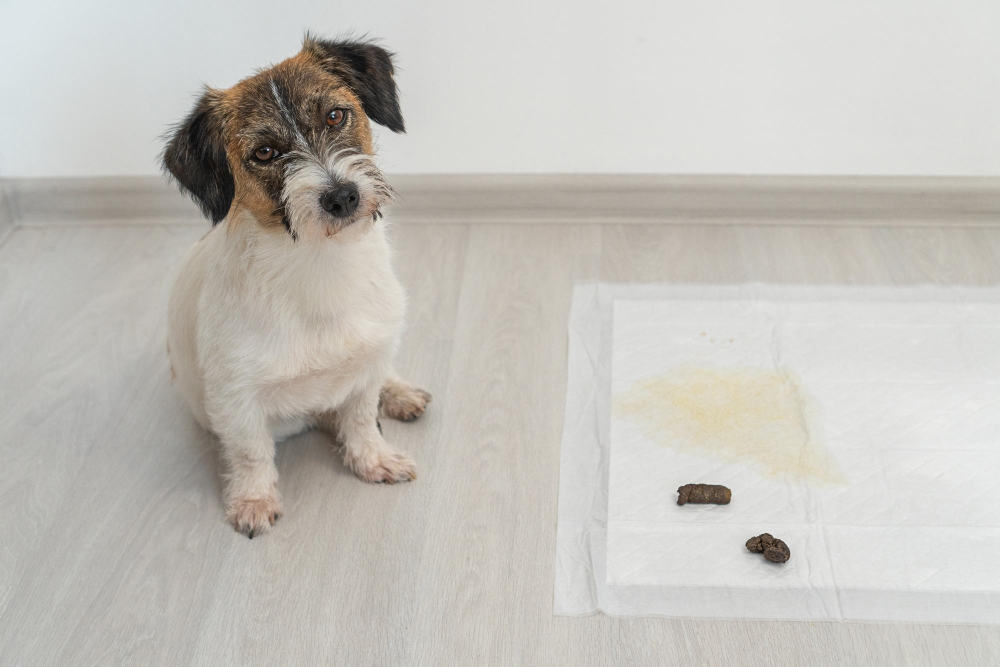
Begin by establishing a routine for house training. Take your dog outside frequently, especially after meals, naps, and playtime. Use positive reinforcement, such as praise and treats, to reward your dog when they go potty outside.
Keep your dog in the same room as you to catch accidents early and quickly take them outside. When you’re not home, confine your dog to a crate or a small room to minimize accidents.
Consider your dog’s age, anxiety issues, or medical conditions that may contribute to the problem and adjust your approach accordingly. You can successfully train your dog to eliminate outside and prevent accidents indoors with consistency and patience.
Rule out health problems.
If you suspect your dog has accidents inside the house, it’s important to rule out any underlying health problems. Sometimes, house soiling can be a sign of a medical issue, such as a urinary tract infection. Training alone won’t solve the problem if your dog has a medical condition causing them to pee inside.
To address this, consult with your veterinarian. They’ll evaluate your dog’s overall health and conduct necessary tests to diagnose and treat any underlying medical conditions. Remember, addressing health problems is crucial in successfully training your dog to not pee in the house.
Create a routine
A consistent routine is crucial when training your dog to avoid peeing inside the house. To successfully house-train your puppy and prevent indoor accidents, it’s important to create a schedule for potty training. Make it a habit to take your dog outside regularly, particularly after meals, playtime, and waking up. This will help them understand that going outside is the appropriate place to relieve themselves.
Crate training can also be beneficial in establishing a routine. When you cannot supervise your dog, confine them to a small area or crate. Pay attention to signs such as restlessness or scratching, indicating they must go outside.
Use positive reinforcement
You can use positive reinforcement to train your dog to avoid peeing inside the house. This method involves praising and rewarding your dog when they go potty outside. It works well with both puppies and older dogs.
When your dog successfully eliminates outside, give them verbal praise, petting, and a treat as a reward. By associating going outside with positive experiences, your dog will learn that going potty outside is the desired behavior.
As your dog becomes more consistent in their potty training, you can gradually reduce the use of treats. Remember to celebrate their success when they go outside so they understand that this behavior is highly valued.
Limit access
To prevent accidents and ensure your dog’s safety, it’s important to limit their access to certain areas when you can’t supervise them. This will help prevent them from peeing inside your house. Here are four practical tips to assist you in house training your dog:
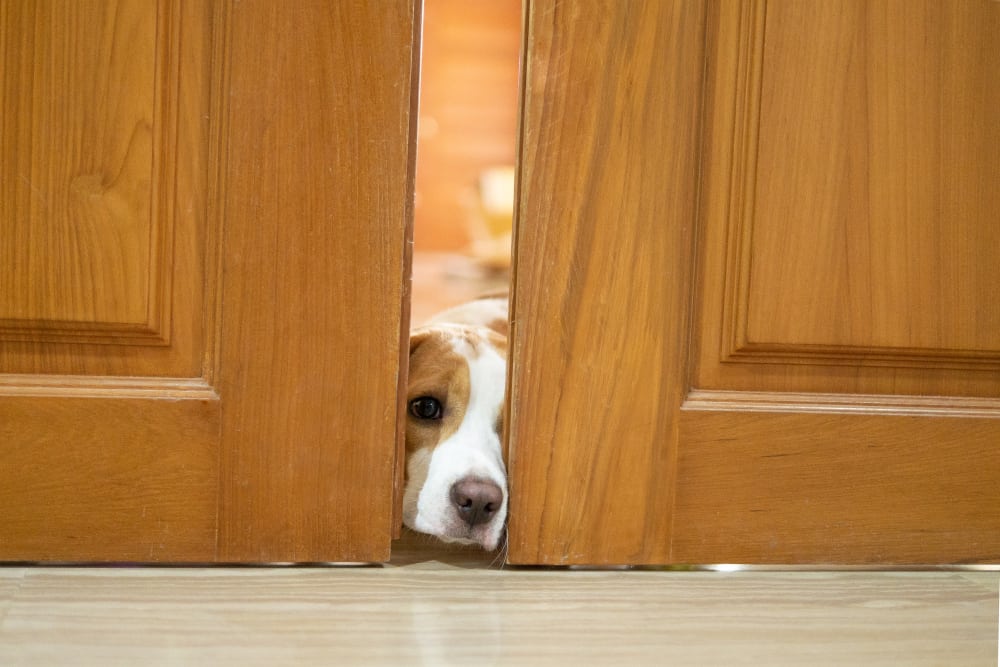
- Create a designated space using baby gates or crates where your dog can stay when you cannot keep an eye on them. This will restrict their access to the rest of the house and reduce the likelihood of accidents.
- Take your dog outside frequently, especially after meals, naps, and playtime, to give them opportunities to relieve themselves. Consistency is key in reinforcing the idea that they should only pee outside.
- When your dog is outside their designated area, closely supervise them for signs they need to go, such as sniffing or circling. If you notice these signs, immediately take them outside.
- Gradually increase your dog’s freedom as they become more reliable in their house training. Start by giving them access to one room at a time and only allow them into other areas once they consistently demonstrate the ability to hold their pee and go outside.
Never Punish
When training your dog not to pee inside, it’s crucial to avoid punishing them for accidents. Punishment can worsen the problem and impede their learning of where to go. Dogs don’t understand punishment like humans, which can create fear and anxiety, leading to more accidents.
Instead of punishment, focus on positive reinforcement and reward-based training. When your dog pees outside, offer praise, treats, or playtime as a reward. By positively reinforcing the desired behavior, your dog will learn that peeing outside is appropriate.
Patience and consistency in your training efforts will eventually lead to your dog learning to pee outside and avoiding accidents inside the house.
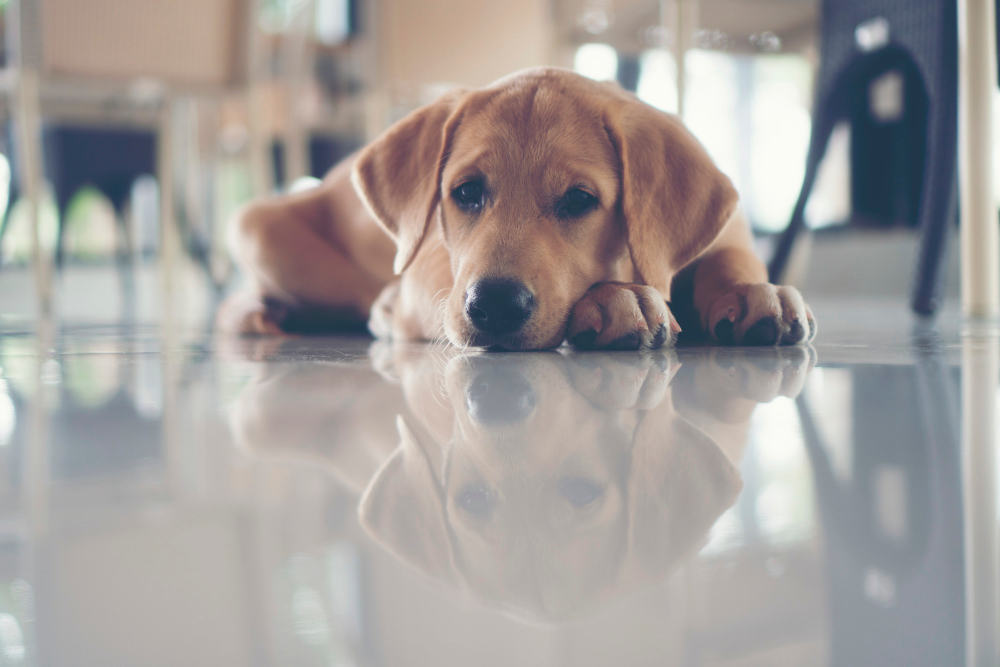
Spay or Neuter Your Dog
Consider spaying or neutering your dog, as it can significantly reduce the urge to mark inside the house. This is especially true for unneutered males, as marking behavior is common in dogs. Spaying or neutering your dog helps prevent them from urinating indoors and maintains a clean, house-trained dog.
Here are four reasons why spaying or neutering can be beneficial in preventing your dog from being eliminated in the house:
- Decreased hormone levels: Spaying or neutering your dog reduces the production of hormones that contribute to marking behavior. This eliminates the urge to mark inside the house.
- Reduced anxiety: Hormones and anxiety often go hand in hand, and both can contribute to dogs marking their territory. Spaying or neutering your dog can alleviate anxiety and decrease the likelihood of them marking inside.
- Prevention of unwanted litter: Spaying or neutering your dog helps with house training and prevents unwanted litter. This reduces the number of homeless dogs and promotes responsible pet ownership.
- Health benefits: Spaying or neutering your dog has various health benefits, including reducing the risk of certain cancers and infections. It can also help with behavioral issues, such as aggression and roaming.
Identify and Eliminate Anxiety Triggers
Identifying and addressing anxiety triggers can help prevent your dog from peeing in the house. Some dogs may urinate indoors due to nervousness, anxiety, or excitement. It’s important to understand what causes fear or excitement in your dog.
Gradually exposing them to these triggers can help them become less sensitive. If possible, limit their exposure to fearful situations to reduce anxiety. You can also explore using anxiety-reducing methods such as calming supplements, pheromone sprays, or training techniques.
Get Professional Help
To get professional assistance with training your dog to avoid peeing in the house, it’s recommended to consult with a qualified dog trainer or behaviorist.
There are several reasons why seeking professional help can be beneficial in this situation:
- Expertise: Trainers and behaviorists have the knowledge and experience to understand the reasons behind your dog’s accidents and can provide customized solutions to address the issue.
- Individualized Approach: Professionals will assess your dog’s specific needs, considering their personality, age, and breed, and create a tailored training plan accordingly.
- Consistency: Consistency is crucial when it comes to housetraining a dog. Professionals can assist in establishing a consistent routine and offer guidance on reinforcing desired behaviors.
- Problem-Solving: If your dog’s accidents persist despite your efforts, a professional can help identify any underlying issues, such as anxiety or medical conditions, and develop strategies to address them effectively.
Increase potty breaks
Are you wondering how often you should increase the frequency of potty breaks when training your dog not to pee inside the house? Increasing the number of potty breaks is a crucial aspect of house training your dog and preventing accidents indoors.
When you begin the training process, it’s recommended to take your dog outside every 2-3 hours to provide them with ample opportunities to eliminate outside. As your dog becomes more comfortable holding their bladder, you can gradually extend the time between potty breaks. However, it’s important to pay attention to your dog’s behavior and any signals they may give indicating the need to go, such as sniffing or circling. If you observe these signs, taking them outside immediately is important.
Crate training can also be beneficial in preventing accidents inside the house, as dogs are less likely to soil their sleeping area. Remember to remain patient and consistent throughout the training process.
Eliminate urinate odors
To effectively train your dog not to pee inside the house, it’s important to eliminate urine odors. Here are four tips to help you get rid of those odors and reinforce proper potty training:
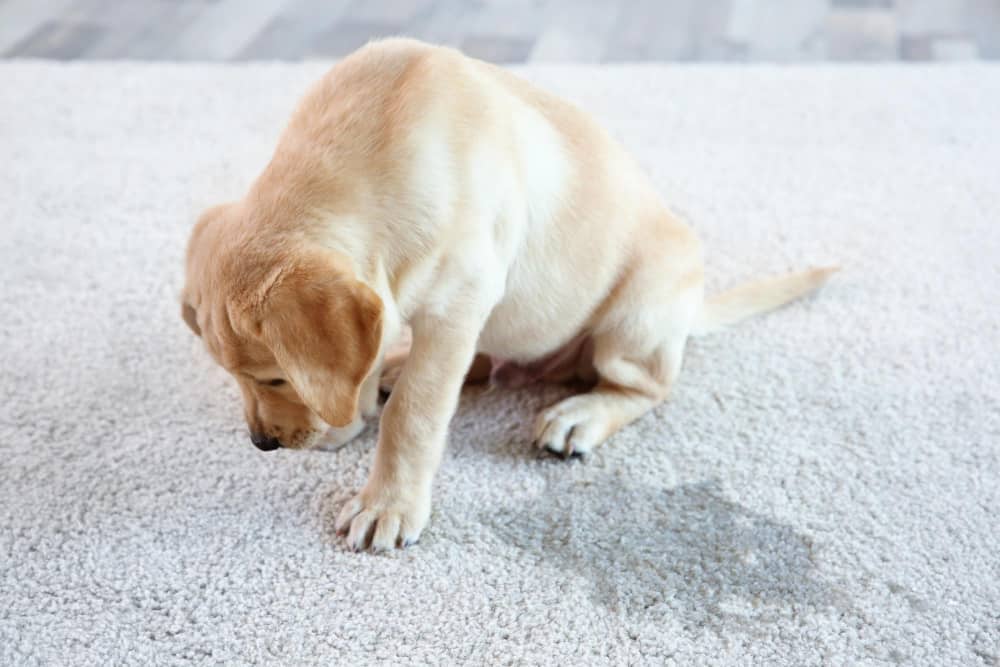
- Clean accidents immediately: Act quickly to clean up any accidents using an enzymatic cleaner designed to neutralize urine odors. This will help remove the scent that may attract your dog to pee in the same spot again.
- Use a crate or confinement area: Utilize a crate or a designated confinement area when you can’t directly supervise your dog. Dogs are less likely to urinate where they sleep or play, making it easier to discourage indoor accidents.
- Ventilate and deodorize: Open windows or use fans to improve airflow and reduce lingering urine odors. Additionally, consider using air fresheners or odor-neutralizing sprays to eliminate any remaining smells.
- Wash bedding and fabrics: Launder any soiled bedding, blankets, or fabrics with a pet-specific odor-eliminating detergent. This will help remove residual urine odors and prevent your dog from being attracted to those areas.
How long does it take to train a dog not to pee inside?
House training a dog not to pee inside requires consistency and patience. You can expect to see progress within a few weeks by establishing a routine and using positive reinforcement.
The time it takes to train a dog not to pee inside can vary depending on the specific dog and their previous experiences. Remember that training a puppy may take longer than an older dog, as puppies have less control over their bladder.
It’s important to be proactive and attentive during the house training process, paying attention to signs such as sniffing, circling, or whining that indicate the puppy needs to go outside. When you notice these signs, immediately take the puppy outdoors.
Remember to maintain patience and consistency in your training efforts, and soon, your dog will learn to relieve themselves outside.
Can pee pads help train your dog?
Using pee pads can be beneficial when training your dog to not pee inside your home. Here are four reasons why they can help:
- Absorbency: Pee pads are designed to absorb urine quickly, which helps keep your floors clean and dry. This feature is particularly helpful in preventing accidents and simplifying the cleanup process.
- Convenience: Pee pads provide a designated spot for your dog to eliminate, making it easier to house-train them. By placing the pads in a specific area of your home, you can help your dog associate that spot with going potty.
- Bladder control: Consistently using pee pads can assist in teaching your dog to hold their bladder for longer periods. Gradually increasing the time between bathroom breaks can improve your dog’s bladder control over time.
- Transition to outdoor pottying: Pee pads can also aid in transitioning your dog from using the pads indoors to going potty outside. Once your dog consistently uses the pee pad, you can gradually move it closer to the door and eventually outside, reinforcing the idea of going potty outdoors.
What frequency do puppies need to be taken out to urinate?
Establishing a regular potty schedule is crucial when house training your puppy and preventing accidents inside the house.
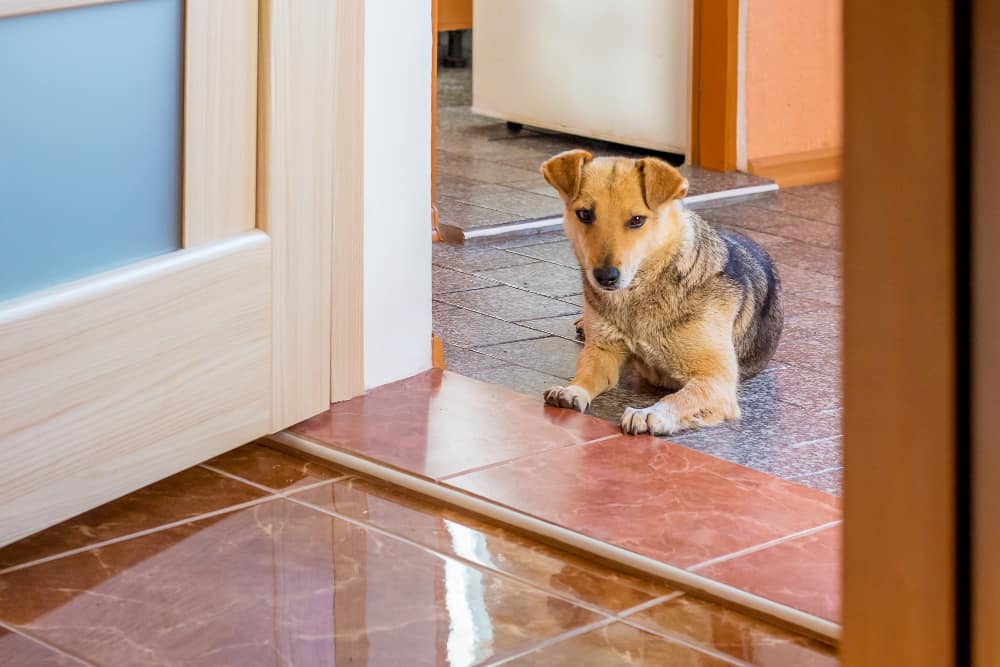
Taking your puppy out every two hours helps them learn to hold their bladder and understand that peeing outside is the desired behavior.
Taking your puppy out after waking up, playing, and eating is also important, as these activities can trigger the need to go potty.
You’re teaching your puppy the appropriate place to relieve themselves by consistently reinforcing the idea of going outside to pee.
Remember to reward your puppy immediately after they are eliminated outdoors to reinforce this behavior further.
Consistency and patience are key when house training your puppy to avoid peeing in the house and promote successful potty training.
Which signs indicate a puppy needs to go out?
Understanding the signs that indicate your puppy needs to go outside is crucial for successful house training. By paying attention to these signals, you can prevent accidents inside and help your dog learn to relieve themselves outdoors.
Here are four common signs to watch out for:
- Restlessness and pacing: If your puppy appears restless and can’t settle down, it may indicate they need to go outside to pee.
- Sniffing and circling: When you notice your puppy sniffing the floor and walking in circles, they search for a suitable spot to do their business.
- Whining or scratching at the door: Your puppy may try to communicate their need to go outside by whining or scratching at the door. Pay attention to these cues as they tell you they must be released.
- Sudden alertness or hyperactivity: If your normally calm puppy suddenly becomes very alert or overly excited, it could indicate an urgent need to go outside.
Recognizing these signs and promptly taking your puppy outside will help them understand that going to the bathroom should be outdoors. This will contribute to a successful house training process.
Conclusion
By following the tips on how to train a dog not to pee inside, you can successfully train your dog not to pee inside the house. It’s important to track your dog’s behavior, use positive reinforcement, and keep your dog in the room with you. You can create a clean and accident-free environment for you and your furry companion with patience and consistency.


